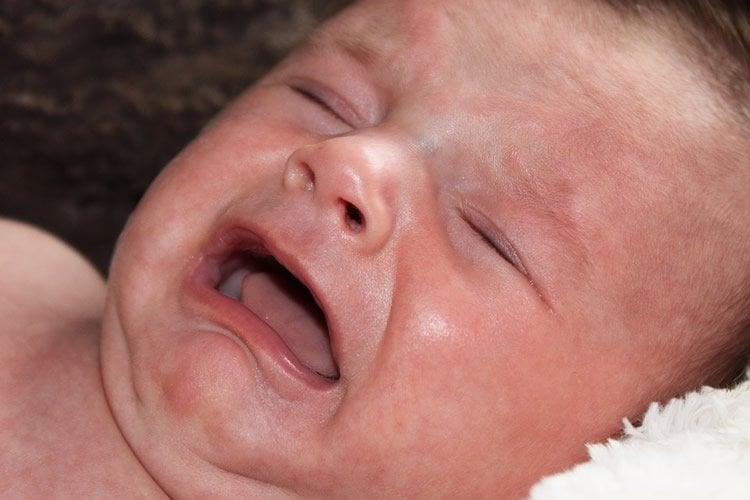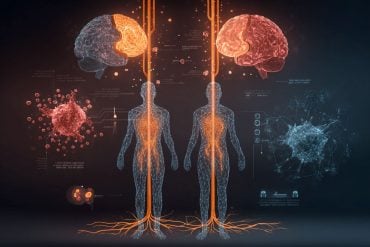Summary: According the researchers, a baby’s cry not only commands our attention, it also has an effect on how adults complete cognitive tasks.
Source: University of Toronto.
A baby’s cry not only commands our attention, it also rattles our executive functions—the very neural and cognitive processes we use for making everyday decisions, according to a new University of Toronto study.
“Parental instinct appears to be hardwired, yet no one talks about how this instinct might include cognition,” says David Haley, co-author and Associate Professor of psychology at U of T Scarborough.
“If we simply had an automatic response every time a baby started crying, how would we think about competing concerns in the environment or how best to respond to a baby’s distress?”
The study looked at the effect infant vocalizations—in this case audio clips of a baby laughing or crying—had on adults completing a cognitive conflict task. The researchers used the Stroop task, in which participants were asked to rapidly identify the color of a printed word while ignoring the meaning of the word itself. Brain activity was measured using electroencephalography (EEG) during each trial of the cognitive task, which took place immediately after a two-second audio clip of an infant vocalization.
The brain data revealed that the infant cries reduced attention to the task and triggered greater cognitive conflict processing than the infant laughs. Cognitive conflict processing is important because it controls attention—one of the most basic executive functions needed to complete a task or make a decision, notes Haley, who runs U of T’s Parent-Infant Research Lab.
“Parents are constantly making a variety of everyday decisions and have competing demands on their attention,” says Joanna Dudek, a graduate student in Haley’s Parent-Infant Research Lab and the lead author of the study.
“They may be in the middle of doing chores when the doorbell rings and their child starts to cry. How do they stay calm, cool and collected, and how do they know when to drop what they’re doing and pick up the child?”
A baby’s cry has been shown to cause aversion in adults, but it could also create an adaptive response by “switching on” the cognitive control parents use in effectively responding to their child’s emotional needs while also addressing other demands in everyday life, adds Haley.
“If an infant’s cry activates cognitive conflict in the brain, it could also be teaching parents how to focus their attention more selectively,” he says.
“It’s this cognitive flexibility that allows parents to rapidly switch between responding to their baby’s distress and other competing demands in their lives—which, paradoxically, may mean ignoring the infant momentarily.”
The findings add to a growing body of research suggesting that infants occupy a privileged status in our neurobiological programming, one deeply rooted in our evolutionary past. But, as Haley notes, it also reveals an important adaptive cognitive function in the human brain.

The study, which is the first to examine the effects of infant vocalizations on adult neural activity during a cognitive task, will be published in the journal PLOS ONE. Marc Bornstein, a Senior Investigator at the Eunice Kennedy Shriver National Institute of Child Health and Human Development (NICHD), Bethesda, Maryland, is also a co-author.
Haley says the next steps for the research will be to look at whether there are individual differences in the neural activation of attention and conflict processing in new mothers that may help or hinder their capacity to respond sensitively to their own infants’ cries.
Funding: The study received funding from the Canada Foundation for Innovation (CFI) and the Natural Sciences and Engineering Research Council of Canada (NSERC)
Source: Don Campbell – University of Toronto
Image Source: This NeuroscienceNews.com image in the public domain.
Original Research: Full open access research for “Infant Cries Rattle Adult Cognition” by Joanna Dudek, Ahmed Faress, Marc H. Bornstein, and David W. Haley in PLOS ONE. Published online May 18 2016 doi:10.1371/journal.pone.0154283
[cbtabs][cbtab title=”MLA”]University of Toronto. “Executive Power in the Nursery: How a Baby’s Cry Rattles Our Executive Functions.” NeuroscienceNews. NeuroscienceNews, 21 May 2016.
<https://neurosciencenews.com/cognitive-conflict-baby-crying-4267/>.[/cbtab][cbtab title=”APA”]University of Toronto. (2016, May 21). Executive Power in the Nursery: How a Baby’s Cry Rattles Our Executive Functions. NeuroscienceNews. Retrieved May 21, 2016 from https://neurosciencenews.com/cognitive-conflict-baby-crying-4267/[/cbtab][cbtab title=”Chicago”]University of Toronto. “Executive Power in the Nursery: How a Baby’s Cry Rattles Our Executive Functions.” NeuroscienceNews.
https://neurosciencenews.com/cognitive-conflict-baby-crying-4267/ (accessed May 21, 2016).[/cbtab][/cbtabs]
Abstract
Infant Cries Rattle Adult Cognition
The attention-grabbing quality of the infant cry is well recognized, but how the emotional valence of infant vocal signals affects adult cognition and cortical activity has heretofore been unknown. We examined the effects of two contrasting infant vocalizations (cries vs. laughs) on adult performance on a Stroop task using a cross-modal distraction paradigm in which infant distractors were vocal and targets were visual. Infant vocalizations were presented before (Experiment 1) or during each Stroop trial (Experiment 2). To evaluate the influence of infant vocalizations on cognitive control, neural responses to the Stroop task were obtained by measuring electroencephalography (EEG) and event-related potentials (ERPs) in Experiment 1. Based on the previously demonstrated existence of negative arousal bias, we hypothesized that cry vocalizations would be more distracting and invoke greater conflict processing than laugh vocalizations. Similarly, we expected participants to have greater difficulty shifting attention from the vocal distractors to the target task after hearing cries vs. after hearing laughs. Behavioral results from both experiments showed a cry interference effect, in which task performance was slower with cry than with laugh distractors. Electrophysiology data further revealed that cries more than laughs reduced attention to the task (smaller P200) and increased conflict processing (larger N450), albeit differently for incongruent and congruent trials. Results from a correlation analysis showed that the amplitudes of P200 and N450 were inversely related, suggesting a reciprocal relationship between attention and conflict processing. The findings suggest that cognitive control processes contribute to an attention bias to infant signals, which is modulated in part by the valence of the infant vocalization and the demands of the cognitive task. The findings thus support the notion that infant cries elicit a negative arousal bias that is distracting; they also identify, for the first time, the neural dynamics underlying the unique influence that infant cries and laughs have on cognitive control.
“Infant Cries Rattle Adult Cognition” by Joanna Dudek, Ahmed Faress, Marc H. Bornstein, and David W. Haley in PLOS ONE. Published online May 18 2016 doi:10.1371/journal.pone.0154283






